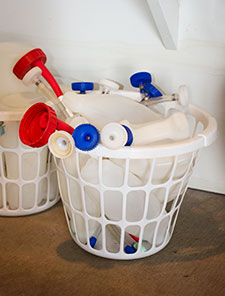 The equipment used to feed calves on your farm may look clean, but is it really? Oftentimes, there's more trouble lurking than the eyes can see.
The equipment used to feed calves on your farm may look clean, but is it really? Oftentimes, there's more trouble lurking than the eyes can see."Many farms place a low importance on proper cleaning," noted Sarah Mills-Lloyd, D.V.M., an agriculture agent with University of Wisconsin-Extension. During her presentation at UW-Extension's Calf Management Seminar, she explained that farms often rush through cleaning because they don't have the time or see its value.
The economic importance is there, though. According to data collected on Wisconsin dairy farms, it costs about $363 to raise a calf from birth to weaning. Beyond the daily costs, you also have to factor in the animal's future genetic value to the lactating herd, Mills-Lloyd said. And every time you have a sick calf, there's a cost associated not only with the medication used but also with the time taken to administer it.
Cleanliness is important all over the dairy, but young calves are especially susceptible to the bugs that may be hanging around. In fact, the median age for rotavirus, coronavirus and Cryptosporidium parvum scours is just 10 days of age, she said.
Why is that? A calf has an immature gut the first 7 to 14 days of life, and very little gastric acid production the first 5 to 7 days. Mills-Lloyd explained that gastric acid is important protection against enteric (bacterial) disease. Add that to a calf's limited immunity the first 2 to 3 weeks of life, and problems can brew up easily.
A newborn calf only has 2.8 percent of its body weight as fat, so when it gets sick, it has very little stores to depend on, Mills noted. For that reason, a well-balanced diet fed with clean bottles or pails is a must.
"Cleanliness is important on all aspects," she said. "Make sure what the calf is ingesting is really clean."
Mills-Lloyd shared this protocol for cleaning calf feeding equipment (source: Dan Sockett with the Wisconsin Veterinary Diagnostic Laboratory)
- Rinse using warm, 90ºF water.
- Soak in hot water greater than 130?F with 1 percent chlorinated alkaline detergent.
- Wash with water greater than 145?F, and use a brush to help eliminate any other residue.
- Rinse using a cold water solution that contains 50 parts per million of chlorine dioxide.
- Dry completely by letting equipment drain before re-using to prevent bacteria growth.
- Final preparation should include spraying the inside and outside of equipment with a 50 parts per million chlorine dioxide solution two hours or less before the next use.

The author is an associate editor and covers animal health, dairy housing and equipment, and nutrient management. She grew up on a dairy farm near Plymouth, Wis., and previously served as a University of Wisconsin agricultural extension agent. She received a master's degree from North Carolina State University and a bachelor's from University of Wisconsin-Madison.








